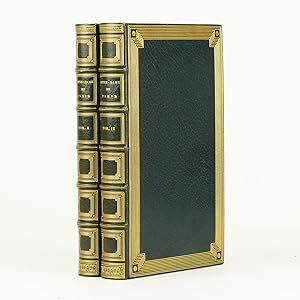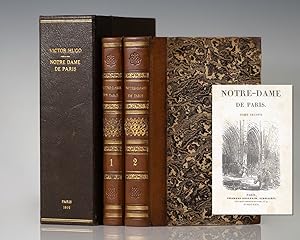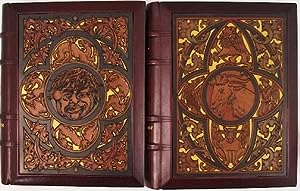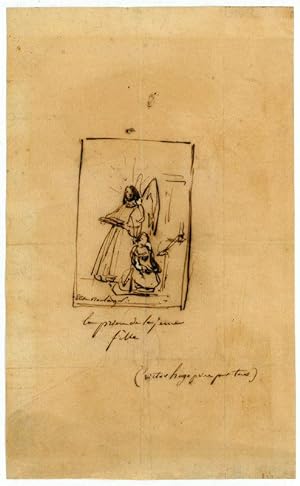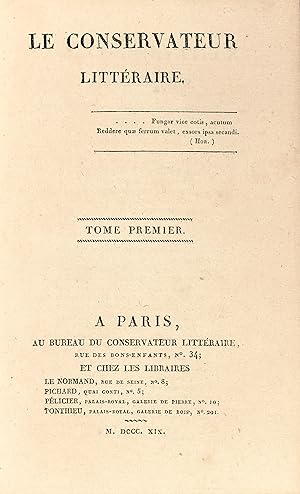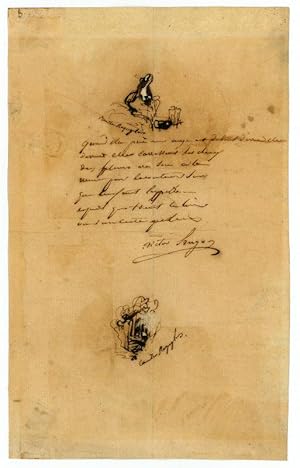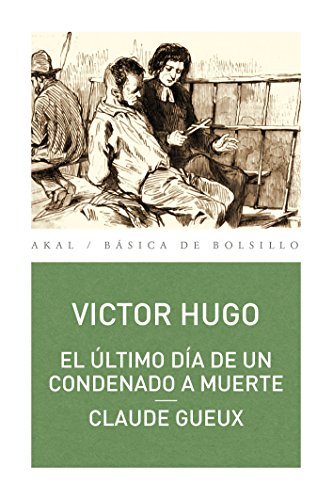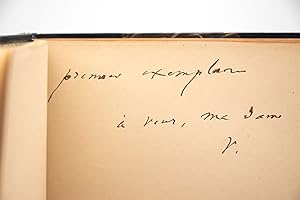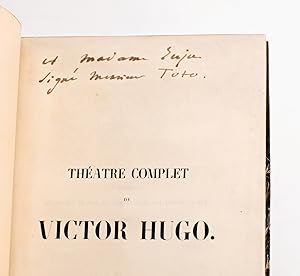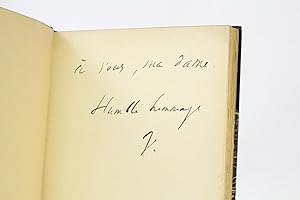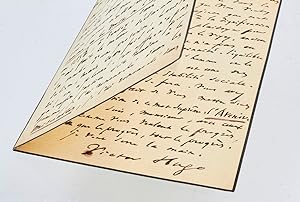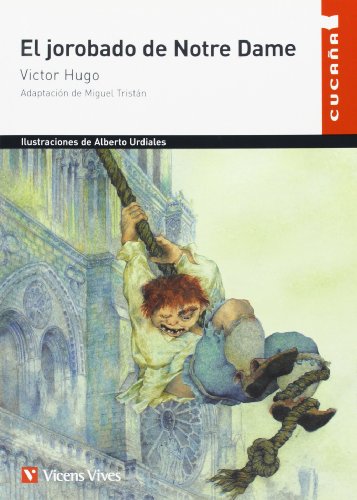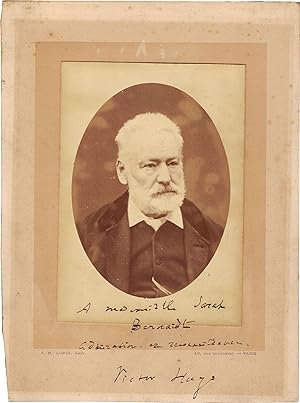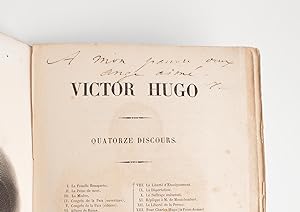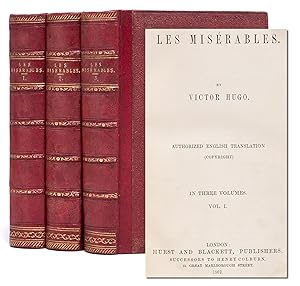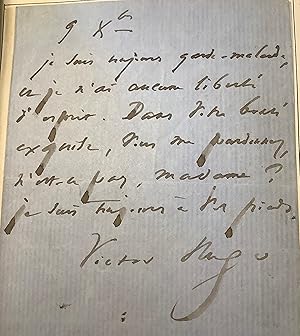Victor Hugo (Over 52,000 results)
Product Type
- All Product Types
- Books (52,693)
- Magazines & Periodicals (32)
- Comics (24)
- Sheet Music (61)
- Art, Prints & Posters (20)
- Photographs (7)
- Maps
-
Manuscripts &
Paper Collectibles (65)
Condition
Binding
Collectible Attributes
- First Edition (1,598)
- Signed (237)
- Dust Jacket (1,468)
- Seller-Supplied Images (22,361)
- Not Printed On Demand (43,021)
Free Shipping
Seller Location
Seller Rating
-
Trabajadores Del Mar, Los, De Hugo, Victor. Editorial Espasa Libros, Tapa Tapa Blanda En Espa ol
Published by Espasa, 1901
ISBN 10: 8467027177ISBN 13: 9788467027174
Seller: Juanpebooks, MIAMI, FL, U.S.A.
Book
Condition: New. Libro nuevo, sellado, fisico, original. Enviamos a todos el mundo por USPS, Fedex y DHL. 100% garantia en su compra. Sealed, new. Unopened. 100%guarentee. We ship worldwide.
-
Théophile Gautier. Notice littéraire précédée d'une lettre de Victor Hugo
Published by Poulet-Malassis et de Broise, 1859
Book First Edition Signed
Couverture rigide. - Poulet-Malassis et de Broise, Paris 1859, 11,5x18cm, relié. - | Envois de Baudelaire & Hugo : la tempétueuse rencontre littéraire de l'Albatros et de l'Homme Océan | Édition originale, dont il n'a été tiré que 500 exemplaires. Portrait de Théophile Gautier gravé à l'eau forte par Emile Thérond en frontisipice. Importante lettre préface de Victor Hugo. Reliure en plein maroquin rouge, dos à cinq nerfs sertis de filets noirs, date dorée en queue, gardes et contreplats de papier à la cuve, ex-libris baudelairien de Renée Cortot encollé sur la première garde, couvertures conservées, tête dorée. Pâles rousseurs affectant les premiers et derniers feuillets, bel exemplaire parfaitement établi. Rare envoi autographe signé de Charles Baudelaire?: «?à mon ami Paul Meurice. Ch. Baudelaire.?» Un billet d'ex-dono autographe de Victor Hugo adressé à Paul Meurice à été joint à cet exemplaire par nos soins et monté sur onglet. Ce billet, qui ne fut sans doute jamais utilisé, avait été cependant préparé, avec quelques autres, par Victor Hugo pour offrir à son ami un exemplaire de ses uvres publiées à Paris, pendant son exil. Si l'histoire ne permit pas à Hugo d'adresser cet ouvrage à Meurice, ce billet d'envoi, jusqu'à lors non utilisé, ne pouvait être, selon nous, plus justement associé. Cette exceptionnelle dédicace manuscrite de Charles Baudelaire à Paul Meurice, véritable frère de substitution de Victor Hugo, porte le témoignage d'une rencontre littéraire unique entre deux des plus importants poètes français, Hugo et Baudelaire. Paul Meurice fut en effet l'intermédiaire indispensable entre le poète condamné et son illustre pair exilé, car demander à Victor Hugo d'associer leurs noms à cette élégie de Théophile Gautier fut une des grandes audaces de Charles Baudelaire et n'aurait sans doute eu aucune chance de se réaliser sans le précieux concours de Paul Meurice. Nègre de Dumas, auteur de Fanfan la Tulipe et des adaptations théâtrales de Victor Hugo, George Sand, Alexandre Dumas ou Théophile Gautier, Paul Meurice fut un écrivain de talent qui se tint dans l'ombre des grands artistes de son temps. Sa relation unique avec Victor Hugo lui conféra cependant un rôle déterminant dans l'histoire littéraire. Plus qu'un ami, Paul se substitua, avec Auguste Vacquerie, aux frères décédés de Victor Hugo?: «?j'ai perdu mes deux frères ; lui et vous, vous et lui, vous les remplacez ; seulement j'étais le cadet ; je suis devenu l'aîné, voilà toute la différence.?» C'est à ce frère de c ur (dont il fut le témoin de mariage au côté d'Ingres et Dumas) que le poète en exil confia ses intérêts littéraires et financiers et c'est lui qu'il désignera, avec Auguste Vacquerie, comme exécuteur testamentaire. Après la mort du poète, Meurice fondera la maison Victor Hugo qui est, aujourd'hui encore, une des plus célèbres demeures-musées d'écrivain. En 1859, la maison de Paul est devenue l'antichambre parisienne du rocher anglo-normand de Victor Hugo, et Baudelaire s'adresse donc naturellement à cet ambassadeur officiel. Les deux hommes se connaissent assez peu mais partagent un ami commun, Théophile Gautier, avec lequel Meurice travailla dès 1842 à une adaptation de Falstaff. Il est donc l'intermédiaire idéal pour s'assurer la bienveillance de l'inaccessible Hugo. Baudelaire avait pourtant déjà brièvement rencontré Victor Hugo. à dix-neuf ans, il sollicita une entrevue avec le plus grand poète moderne, auquel il vouait un culte depuis l'enfance?: «?Je vous aime comme on aime un héros, un livre, comme on aime purement et sans intérêt toute belle chose.?». Déjà, il se rêvait en digne successeur, comme il lui avoue à demi-mot?: «?à dix-neuf ans eussiez-vous hésité à en écrire autant à [.] Chateaubriand par exemple?». Pour le jeune apprenti poète, Victor Hugo appartient au passé, et Baudelaire souhaitera rapidement s'affranchir de ce pesant modèle. Dès son premier ouvrage, Le Salon de 1845, l'iconoclaste Baudelaire éreinte son ancienne idole en déclarant la fin du.
-
Couverture rigide. Condition: Très bon. Paris, Pagnerre, 1862.10 volumes grand in-8 de : I/ (4) ff., 357 pp. (mal numérotées 355), (1) f.bl., 2 illustrations hors texte ; II/ (2) ff., 382 pp., (1) f.bl., 2 illustrations hors texte ; III/ (2) ff., 358 pp., (1) f.bl., 2 illustrations hors texte ; IV/ (2) ff., 318 pp., (1) f.bl., 2 illustrations hors texte ; V/ (2) ff., 320 pp., 1 illustration hors texte ; VI/ (2) ff., 297 pp., (1) f.bl., 2 illustrations hors texte ; VII/ (2) ff., 432 pp., 2 illustrations hors texte ; VIII/ (2) ff., 399 pp., 3 illustrations hors texte ; IX/ (2) ff., 400 pp., 2 illustrations hors texte ; X/ (2) ff., 311 pp., 2 illustrations hors texte, (2) ff. d'album. Suite des 20 gravures sur acier par Outhwaite d'après Castelli et De Neuville, publiée par Lacroix et Verboecken en 1869. Couvertures illustrées de la suite reliées en fin du tome X.Demi-maroquin rouge à coins, filets dorés aux coins et aux mors, dos à nerfs ornés de filets dorés, caissons ornés d'une grecque, têtes dorées, nombreux témoins. Reliure de l'époque signée de Champs.238 x 150 mm. --- Édition originale française de ce grand roman de Hugo, vaste réquisitoire social, publié lors de l'exil de l'auteur à Guernesey.Exemplaire de première émission, sans mention d'édition.Clouzot, Guide du bibliophile, 150 ; Talvart, IX, p.40 ; Carteret, I, 421.« Ouvrage capital et universellement estimé. Un des plus colossaux succès de librairie, c'est un des livres qui s'est le plus vendu ; il se vend et se vendra encore longtemps ». (Carteret).L'un des rarissimes exemplaires sur papier vert d'eau du chef-d'?uvre romanesque de Victor Hugo.Les bibliographes indiquent qu'il a été tiré « quelques exemplaires » sur papier de Hollande et sur papier vert d'eau « qui sont fort rares ». Carteret cite trois exemplaires sur Hollande mais aucun sur papier vert d'eau. Vicaire quant à lui ne cite qu'un exemplaire sur papier vert d'eau, celui de Jules Janin.Les exemplaires du tirage sur papier de couleur ne /// Paris, Pagnerre, 1862.10 large 8vo volumes [238 x 150 mm] of: I/ (4) ll., 357 pp. (misnumbered 355), (1) bl.l., 2 illustrations out of pagination; II/ (2) ll., 382 pp., (1) bl.l., 2 illustrations out of pagination; III/ (2) ll., 358 pp., (1) bl.l., 2 illustrations out of pagination; IV/ (2) ll., 318 pp., (1) bl.l., 2 illustrations out of pagination; V/ (2) ll., 320 pp., 1 illustration out of pagination; VI/ (2) ll., 297 pp., (1) bl.l., 2 illustrations out of pagination; VII/ (2) ll., 432 pp., 2 illustrations out of pagination; VIII/ (2) ll., 399 pp., 3 illustrations out of pagination; IX/ (2) l., 400 pp., 2 illustrations out of pagination; X/ (2) ll., 311 pp., 2 illustrations out of pagination, (2) ll. of album. Suite of 20 copper-engravings by Outhwaite after Castelli and De Neuville, published by Lacroix and Verboecken in 1869. Illustrated wrappers of the suite bound at the end of part 10.Red quarter-morocco, gilt fillets on the corners and joints, spines ribbed and decorated with gilt fillets and Greek gilt patterns, top edge gilt, many untrimmed edges. Contemporary binding signed by Champs. --- First French edition of this great novel by Hugo, large social indictment, published during the author's exile in Guernsey.Copy from the first issue, without any mention of edition.Clouzot, Guide du bibliophile, 150 ; Talvart, IX, p.40 ; Carteret, I, 421."Major work universally esteemed. One of the greatest best-sellers, it is one of the books the most sold; it is sold and will be sold for a long time" (Carteret).One of the very few copies printed on sea-green paper of Victor Hugo's fictional masterpiece.Bibliographers mention that "a few copies" have been printed on Dutch paper and on sea-green paper "which are extremely rare". Carteret mentions three copies on Dutch paper but none on sea-green paper. As for Vicaire, he only mentions one sea-green paper copy, the one of Jules Janin.Copies from the deluxe issue on coloured paper were distributed only later. After.
-
A collection of three plays by Victor Hugo, including "Lucrèce Borgia", enriched with additional collector's pieces, including a letter signed by Lucrezia Borgia, an autograph musical manuscript by Donizetti, and an original drawing by Victor Hugo.
Published by Paris, Eugène Renduel, 1832-1833., 1833
Seller: Antiquariat INLIBRIS Gilhofer Nfg. GmbH, Vienna, A, Austria
Manuscript / Paper Collectible Signed
I) Lucrèce Borgia. 1833. (2), XI, (1), 192 pp. - II) Le Roi s'amuse. 1832. (8), XXIII, (1), 183 pp. - III) Marie Tudor. 1833. (6), IV, 214 pp. Each with frontispiece. All three bound in a single volume in slightly later half calf with giltstamped spine and marbled covers. - A matching second volume contains: - 1) Borgia, Lucrezia (1480-1519). Letter signed. Rome, 20 Nov. 1501. ½ p. Folio. - 2) Hugo, Victor (1802-1885). Autograph ink caricature, mounted on backing paper. 10 x 13 cm. - 3) Mocquard, Jean-François (1791-1864). Autograph letter signed. Paris, 15 Jan. 1853. 1 p. 8vo. - 4) Fournier, Louis Edouard (1857-1917). Autograph drawing inscribed. 12.5 x 20.5 cm. - 5) Donizetti, Gaetano (1797-1848). Autograph musical manuscript (fragment). 6 pp., ca. 33 x 12 cm. - 6) Hugo, Victor (1802-1885). Two autograph instructions signed. 26 Dec. 1839 and 20 Feb. (no year). Oblong 8vo. 2 pp. - Both volumes stored together in a matching calf-entry marbled slipcase. A charming ensemble of three first editions of Victor Hugo's plays, each one inscribed by the author to his elder brother, the essayist and military writer Abel Hugo (1798-1855). When the set was auctioned at the sale of the library of the author's grandson Georges-Victor Hugo, it was acquired by Arthur Meyer, the director of the prestigious daily "Le Gaulois" and a passionate collector who was wont to enrich, or "truffle", his books with appropriate rare autographs and drawings. In this case, the addenda, bound in a matching half-calf volume, greatly surpass in value the works they accompany: 1) A precious letter by the Renaissance noblewoman Lucrezia Borgia, famous for her marriages and her affair with Pietro Bembo (signed "Lucretia Esteri de Borgia"), written in recommendation of Hector Beringero to the poet Antonio Tebaldeo (1463-1537), secretary to Francesco II Gonzaga, Marquess of Mantua (later Lucrezia's lover). Meyer had acquired this outstanding document from the collection of Alfred Morrison (cf. Catalogue of the Collection of Autograph Letters and Historical Documents Formed Between 1865 and 1882 by Alfred Morrison, 1883, p. 100). - 2) Almost equally striking is the original, highly expressive pen-and-ink drawing by Victor Hugo, showing the dark shape of a portly figure holding a candle (an illustration of Act III, Scene 1 of his 1843 play "Les Burgraves"), captioned by the artist in his own hand: "Mm. Mélingue criant: Caïn! de la Coulisse". In the original production, the actress Rosaline Mélingue had played the role of Guanhumara, providing the off-stage voice for the eerie scene. - 3) Also included is a letter by J.-F. Mocquard, chief-of-staff to Napoleon III, addressed to Auguste Romieu, the directeur des beaux-arts, concerning matters of theatrical censorship (including Hugo's play "Lucrèce Borgia"). 4) The associations are reinforced in an expressive charcoal drawing showing Victor Hugo reading to his brother Abel the first act of "Lucrèce Borgia", inscribed in pencil to the collector by the artist L. E. Fournier: "A M. Arthur Meyer très cordialement". 5) Finally, Meyer was able to include a fragment of Gaetano Donizetti's original manuscript of his 1833 opera "Lucrezia Borgia", which he had based on Hugo's play. 6) At the very end are two brief notes by Victor Hugo in which the author instructs his publisher Renduel to issue to the bearer copies of his works, including "Lucrèce Borgia". - Provenance: bookplates of Arthur Meyer and Jean Inglessi, as well as an additional monogrammed bookplate. Last in the collection of Pierre Bergé (1930-2017).
-
Victor Hugo - Los Miserables - Libro Completo
Published by Gradfico, 2016
ISBN 10: 9875710687ISBN 13: 9789875710689
Seller: Juanpebooks, MIAMI, FL, U.S.A.
Book
Condition: New. Libro nuevo, sellado, fisico, original. Enviamos a todos el mundo por USPS, Fedex y DHL. 100% garantia en su compra. Sealed, new. Unopened. 100%guarentee. We ship worldwide.
-
Notre-Dame de Paris.
Published by Paris: Charles Gosselin, 1831, 1831
Seller: Peter Harrington. ABA/ ILAB., London, United Kingdom
First Edition
First edition, first printing, first issue, of Hugo's gothic masterpiece, in a contemporary binding. "This first edition. is the rarest of all the works of Victor Hugo; it has had a resounding impact worldwide, and is one of the most difficult titles of the Romantic period to obtain" (Carteret). Copies of this issue preserved in contemporary bindings are exceedingly scarce. Published on 16 March 1831 in an edition of 1,100 copies, the first printing was issued in four separate groups of 275 each, with the subsequent three issues being fictitiously labelled as the second, third and fourth editions on their respective title pages. "The success of this darkly moving novel was immediate, establishing Hugo as the premier historical novelist of his time. Lamartine called him 'the Shakespeare of prose fiction'" (The New Oxford Companion to Literature in French). Clouzot 86-87: "Les exemplaires de la premiere tranche, sans mention d'edition et sans nom d'auteur sont extremement rares"; Carteret Romantique I, 400; Lhermitte 317; Ray French Illustrated Book 180; Vicaire IV, 256. 2 volumes, octavo (200 x 120 mm). Contemporary tree sheep, spines gilt with red morocco lettering- and numbering-pieces. Housed in marbled slipcase. With half-titles. Wood-engraved title vignettes by Tony Johannot. Provenance: Juste Daniel Olivier, 1807-1876, Swiss poet (calligraphic gift inscription signed "Olivier" with red wax seal on front flyleaf, dated 19 April 1832, recipient illegible). Joints and extremities discreetly restored, joints rubbed at head, some pale foxing, a very good copy.
-
Nuestra Se ora De Par s Volumen 2 Lacombe Edelvives
ISBN 10: 8426390919ISBN 13: 9788426390912
Seller: Juanpebooks, MIAMI, FL, U.S.A.
Book
Condition: New. Libro nuevo, sellado, fisico, original. Enviamos a todos el mundo por USPS, Fedex y DHL. 100% garantia en su compra. Sealed, new. Unopened. 100%guarentee. We ship worldwide.
-
Nuestra Se ora De Paris - Albumes
Published by Editorial Luis Vives (Edelvives), 2013
ISBN 10: 8426384234ISBN 13: 9788426384232
Seller: Juanpebooks, MIAMI, FL, U.S.A.
Book
Condition: New. Lacombe, Benjamin (illustrator). Libro nuevo, sellado, fisico, original. Enviamos a todos el mundo por USPS, Fedex y DHL. 100% garantia en su compra. Sealed, new. Unopened. 100%guarentee. We ship worldwide.
-
Notre-Dame de Paris [The Hunchback of Notre Dame]
Published by Charles Gosselin, Paris, 1831
Seller: Burnside Rare Books, ABAA, Portland, OR, U.S.A.
First Edition
Condition: Near Fine. First Edition. First edition, first printing, first issue. [8], 404; [4], 536 pp. Bound in modern gilt armorial stamped morocco green leather bindings with marbled endpapers; wood-engraved title vignettes by Tony Johannot. Near Fine with light toning and minor patches of foxing throughout else fine. Victor Hugo's Gothic French masterpiece printed by Gosselin in a run of 1,100 copies on March 16, 1831; this first printing was distributed into four separate issues of 275 copies each, the subsequent three issues being designated as "second edition," "third edition," and "fourth edition" respectively on the title-pages. "This first edition is the rarest of all the works of Victor Hugo; it has had a resounding impact worldwide, and is one of the most difficult titles of the Romantic period to obtain" (Carteret).
-
NOTRE-DAME DE PARIS
Published by Paris: Charles Gosselin Libraire, 1831
Seller: Jonkers Rare Books, Henley on Thames, OXON, United Kingdom
First Edition
First edition, first issue with no subsequent edition statement on the title page. Two volumes, exquisitely bound by Cuzin in mid-nineteenth century full green morocco with raised bands to the spine and geometric border design to covers and spine compartments. Titled in gilt, with gilt dentelles and edges and marbled endpapers. 212mm x 130mm (page size). Engraved title pages to both volumes, complete with half titles. A fine, tall set, barely trimmed with many leaves uncut, all beautifully clean with no chips or tears. Two inconspicuous book-labels to the front blank. The binding has been retained in sparklingly fine condition. A superb example of this rarity of Gothic literature in a fine Parisian binding. The author's first full length novel, that is now one of the key works of nineteenth century literature, and upon which much of the author's reputation rests. The first edition was published in an edition of 1100 copies which was subdivided into four issues with a different edition statement on the title page. Thus there are only 275 copies of the first issue. The book has subsequently been published in English under the title, "The Hunchback of Notre Dame". Francisque Cuzin (1836-1890) was regarded as the finest bookbinder in the world at the time. "If you want a volume bound in the highest style of art the man to go to is M. Cuzin of the Rue Séguier. who took early to bookbinding, and is now at the head of the handicraft in Paris, and perhaps the world." - The Pall Mall Gazette (December 1886). "This first edition, in fine condition, is the rarest of all the works of Victor Hugo; it has had a resounding impact worldwide, and is one of the most difficult titles of the Romantic period to obtain" (Translated from Carteret - Le Trésor du Bibliophile Romantique et Moderne) Carteret I 402.
-
Notre-Dame de Paris.
Published by Charles Gosselin, Paris, 1831
Seller: Raptis Rare Books, Palm Beach, FL, U.S.A.
First Edition
First edition, first printing of Hugo's masterpiece, one of only 1,100 examples. Octavo, 2 volumes, bound in half calf. The publisher Charles Gosselin published the novel on 16 March 1831 in an edition of 1,100 copies as was his usual practice. It was such a sensation that an additional three printings had to be published the same year. The first impression of 1100 copies was separated into four groups, each bearing a fictitious edition statement on the title-page, a scheme designed to make the public believe that the novel was selling rapidly. "This first edition is the rarest of all the works of Victor Hugo; it has had a resounding impact worldwide, and is one of the most difficult titles of the Romantic period to obtain" (Carteret). In near fine condition. Housed in a custom half morocco clamshell box. Rare and desirable. â The Hunchback of Notre Dame was a revelation of what an historical novel could beâ (Reid, 296). First published in 1831 as Notre-Dame de Paris, Hugoâ s book is â a stunning novelistic representation of late-medieval Paris and its central pointâ ¦ [While it] firmly rejects the idealization of the Middle Ages frequent among Romantic apologists for the ancien rà gimeâ ¦ Hugoâ s novel was a hugely influential revelation of the descriptive intensity of Romantic proseâ (Hollier, 662). The book has seen numerous screen adaptations, including director William Dieterleâ s 1939 version starring Charles Laughton and Maureen Oâ Hara (the most expensive RKO production to that date) and the 1996 animated feature from Disney Studios.
-
NOTRE-DAME DE PARIS
Published by Paris Émile Testard 1889, 1889
Seller: Buddenbrooks, Inc., Newburyport, MA, U.S.A.
Signed
2 volumes. Limited issue of the Édition Nationale, one of only 250 copies printed on Japon of a total edition of only 1000 copies. Illustrated with large engraved pictorial head-pieces by Luc-Olivier Merson each provided in two states, one in place and one on an adjacent plate and with a number of full page engraved plates also by Merson and also provided in two states, an engraved portrait of Hugo in each volume, printed by Gery-Bichard. Large 4to, lusciously bound by Charles Muenier, one of his 'Cuir Incisé' bindings and a fine, large example. The bindings are of full chocolate morocco, laid into the boards are large panels incorporating alternative materials, with elaborate and laid designs of gargoyles, leaves, angels and griffons worked within the framework of a Rose Window. In the center of each window are large circular inlays featuring; a portrait of Quasimodo, a goat, a gargoyle and a spider on its web. The spines feature tall raised bands ruled in blind with handsome gilt lettering and a red and brown morocco inlay portrait of Quasimodo, the inside boards are finished in brown crushed levant with an elaborate gilt and blind panel design, the flies are of marbled paper backed in silk, a.e.g. Each volume has a matching chocolate morocco chemise trimmed with fine marbled paper, the spines are with raised bands matching those of the volumes and with gilt lettering and with rose-window tooling. There are matching marbled paper and morocco slipcases for each volume. The publisher's original printed wrappers to the books have been preserved inside these magnificent bindings. 371, (1); 424, (8) pp. A superb copy with both volumes in extremely fine condition. A MAGNIFICENT BELLE ÉPOQUE SIGNED AND DATED BINDING BY CHARLES MUENIER IN HIS FINEST 'CUIR INCISÉ' FASHION. In this binding style in which a panel of incised leather is worked and molded and then sunk into thick boards of traditional morocco. To succeed in this technique requires great delicacy of handling, but when done correctly provides an equally great scope for emblematic treatment. Meunier was one of the small handful of masters in this technique. Effective and daring, Muenier brought this craft created by Grolier to a new more latter-day aesthetic. he particularly aimed to achieve an artistic and psychological interpretation of the contents of every book he bound. A studentand thinker, as well as a craftsman, he believed that the chaste and formal bindings to which we are all accustomed were impersonal and inexpressive. He held that that they seldom or never bore the slightest relation to the text they held within. In short, Muenier wanted us to be able to judge a book by its cover. To achieve this, Meunier combined the restrained craftsmanship of the early masters with the bolder inventions of the nouveau style.
-
Autograph sketch signed.
Published by N. p., c. 1830., 1830
Seller: Antiquariat INLIBRIS Gilhofer Nfg. GmbH, Vienna, A, Austria
Manuscript / Paper Collectible
1 p. 8vo. Fine draft designed for an illustrated edition of "Feuilles d'Automne" ("Autumn Leaves") for which no record exists, entitled "La prière de la jeune fille" (The prayer of the young girl), signed "Victor Hugo prière pour tous" and the name of the artist Elise Boulanger.
-
Couverture rigide. Condition: Très bon. Paris, au Bureau du Conservateur littéraire, 1819-20.3 volumes in-8 de : I/ (1) f., 404 pp., 2 portraits hors-texte dont un à double page ont été ajoutés au début du volume ; II/ (2) ff., 404 pp. mal ch. 504 ; III/ 416 pp. Relié en demi-maroquin vert à grain long à coins, dos lisses ornés d'un motif romantique doré en long, filets dorés sur les plats. V. Champs.197 x 125 mm. --- Edition originale « extrêmement rare » (Clouzot, Guide du Bibliophile Français, p. 142) contenant notamment l'édition originale de Bug-Jargal.En 1819, par le conseil de Chateaubriand, qui avait deviné le talent littéraire des trois frères Hugo et qui s'intéressait à leur avenir, Abel fonda, de concert avec Eugène et Victor, Le Conservateur littéraire. Cette revue devait être, dans sa pensée, le complément indispensable du Conservateur politique, auquel la collaboration de Chateaubriand avait donné tant de vogue et tant d'éclat. Les trois frères qui vivaient dans une touchante harmonie, et qui n'avaient pas d'autre rivalité que l'amour des lettres, étaient à peu près les seuls rédacteurs du Conservateur littéraire, dans lequel chacun d'eux reparaissait continuellement sous différents pseudonymes et sous des initiales différentes. Chacun d'eux était tour à tour critique, poète, romancier, moraliste, pour varier la rédaction des livraisons hebdomadaires, qui produisaient toujours beaucoup d'effet dans le petit monde des écrivains, sans amener les abonnés à l'aide desquels le recueil aurait pu continuer. Enfin après dix-huit mois de persévérance et d'effort, il fallut renoncer à une publication qui ne faisait pas ses frais.« Il n'a paru de cette Revue que trente livraisons formant trois volumes in-8, Paris, A. Boucher, 1819-20. On lit dans une note du ?Catalogue de livres provenant de la bibliothèque de M. de N***' (1856) ?Victor Hugo écrivait sous son nom et sous diverses initiales pseudonymes la plupart des articles de critique lit /// 3 volumes 8 vo [197 x 125 mm] of : I/ (1) l., 404 pp., 2 portraits out-of-text, one of which on double-page, have been added at the beginning of the volume; II/ (2) ll., 404 pp. wrongly numbeed 504 ; III/ 416 pp. Bound in green straight-grained half-morocco, flat spines decorated with a romantic gilt motif, gilt fillets on the covers. V. Champs. --- "Extremely rare" first edition (Clouzot, Guide du Bibliophile Français, p. 142) containing among others the first edition of Bug-Jargal.In 1819, on the advice of Chateaubriand, who had guessed the literary talent of the three Hugo brothers and who was interested in their future, Abel founded, together with Eugène and Victor, Le Conservateur littéraire. This review was to be, in his mind, the indispensable complement of the Conservateur politique, to which the collaboration of Chateaubriand had given so much vogue and brilliance. The three brothers who lived in a touching harmony, and who had no other rivalry than the love of letters, were more or less the only editors of the Conservateur littéraire, in which each one of them appeared continuously under different pseudonyms and under different initials. Each of them was in turn a critic, a poet, a novelist, a moralist, in order to vary the writing of the weekly deliveries, which always produced a lot of effect in the small world of the writers, without bringing the subscribers with the help of whom the collection could have continued. Finally, after eighteen months of perseverance and effort, it was necessary to give up a publication that did not pay for itself."Only thirty issues of this Revue were published, forming three volumes 8vo, Paris, A. Boucher, 1819-20. We read in a note of the 'Catalogue de livres provenant de la bibliothèque de M. de N***' (1856) 'Victor Hugo wrote under his own name and under various pseudonymous initials most of the articles of literary criticism that he did not collect in his Mélanges. We also find the first edition of Bug-Ja.
-
Autograph manuscript signed, with two autogr. sketches.
Published by N. p., c. 1830., 1830
Seller: Antiquariat INLIBRIS Gilhofer Nfg. GmbH, Vienna, A, Austria
Manuscript / Paper Collectible
1 p. 8vo. Framed. First verse of the eighth session of the poem "La Prière pour tous" ("The prayer for all of us") without the third and last verses: "Quand elle prie un ange est debout [.] / [.] caressant ses cheveux des plumes de son aile [.] / venu pour l'ectouer sans / que l'enfant l'appelle / esprit qui tient le livre / où l'innocente épèlle [.]". Includes two small sketches with the name of the artist Camille Roqueplan. - Formerly folded; uniformly browned, linenbacked, tiny holes from the acidic ink.
-
Ultimo Dia De Un Condenado A Muerte / Claude Gueux - Victor
Published by Ediciones Akal, 2018
ISBN 10: 8446029340ISBN 13: 9788446029342
Seller: Juanpebooks, MIAMI, FL, U.S.A.
Book
Condition: New. Libro nuevo, sellado, fisico, original. Enviamos a todos el mundo por USPS, Fedex y DHL. 100% garantia en su compra. Sealed, new. Unopened. 100%guarentee. We ship worldwide.
-
Couverture rigide. - Calmann Lévy, Paris 1879, 15x24cm, relié. - Édition originale. Reliure en demi chagrin bleu nuit à coins, dos à quatre nerfs sertis de pointillés dorés orné de doubles caissons dorés agrémentés d'arabesques latérales et d'étoiles dorées, date et mention «?ex. de J. Drouet?» dorées en pied, plats de papier marbré, gardes et contreplats de papier à la cuve, couvertures et dos conservés (restaurations marginales sur les plats), tête dorée, ex-libris Pierre Duché encollé sur une garde, élégante reliure signée de René Aussourd. Exceptionnel envoi autographe signé de Victor Hugo à Juliette Drouet, le grand amour de sa vie?: «?Premier exemplaire à vous, ma dame. V.?» Composé en 1857, ce long poème philosophique sur la Révolution était originellement destiné à conclure la Légende des siècles. Victor Hugo le publie finalement en 1879 à l'occasion de sa prise de position en faveur des communards. Plaidoyer pour l'abolition de la peine de mort, La Pitié suprême illustre l'une des premières et plus ferventes luttes politiques de Hugo, qu'il mène encore à l'aube de ses 80 ans?: «?Si mon nom signifie quelque chose en ces années fatales où nous sommes, il signifie Amnistie.?» (Lettre aux citoyens de Lyon, 1873) Confrontant Hugo et Machiavel, J. C. Fizaine souligne la rigueur intellectuelle du poète au service d'un humanisme érigé en principe universel?: «?Machiavel s'adresse à ceux qui veulent devenir princes. Hugo s'adresse pour commencer aux peuples, qui ont subi la tyrannie?: c'est La Pitié suprême, qui définit ce qui doit rester immuablement sacré, la vie humaine, sans que la haine, le ressentiment, le souvenir des souffrances passées autorisent à transgresser cet interdit, sous peine de ne pouvoir fonder aucun régime politique et de retomber en-deçà de la civilisation.?» (Victor Hugo penseur de la laïcité - Le clerc, le prêtre et le citoyen) C'est auprès de Juliette Drouet qu'il mène ce dernier combat. Publié en février 1879, peu après leur installation avenue d'Eylau, La Pitié suprême semble un écho politique à la nouvelle légitimité conquise par les deux vieux amants après cinquante ans d'amours coupables. L'ultime combat de Hugo en faveur de l'amnistie et le pardon résonne dans sa vie affective à l'instar du poème qu'il composera à la mort de Juliette en 1883?: «?Sur ma tombe, on mettra, comme [une grande gloire, Le souvenir profond, adoré, combattu, D'un amour qui fut faute et qui devint [vertu.?» Très bel exemplaire parfaitement établi et d'une extraordinaire provenance, la plus désirable que l'on puisse souhaiter. [ENGLISH TRANSLATION FOLLOWS] HUGO Victor La Pitié suprême [The Supreme Compassion] Calmann Lévy, Paris 1879, 150 x 240 mm (5 15/16 x 9 7/16 "), half shagreen First edition. Elegant half dark blue shagreen over marbled paper boards by René Aussourd, spine in four compartments with gilt dots and double gilt compartments containing horizontal arabesques and gilt stars, date and "ex. de J. Drouet" in gilt to foot, marbled endpapers and pastedowns, covers and spine preserved (marginal repairs to covers), top edge gilt, ex-libris of Pierre Duché on one endpaper. An exceptional autograph inscription from Victor Hugo to Juliette Drouet, the love of his life: "The first copy for you, my lady. V." Written in 1857, this long philosophical poem on the Revolution was originally meant to conclude the Légende des Siècles. Victor Hugo eventually published it in 1879 when he took a stand on behalf of the Communards. Pleading for the abolition of the death penalty, La Pitié suprême highlights one of the first and most heartfelt of Hugo's political struggles, which he carried on till the very end of his 80s: "if my name stands for anything in these deadly times in which we live, it stands for Amnesty" (Letter to the citizens of Lyon, 1873). Comparing Hugo and Machiavelli, J. C. Fizaine underlines the intellectual rigor of the poet who put himself at the service of a humanism elevated into a universal principle: "Machiavelli writes.
-
Théâtre de Victor Hugo. Hernani - Marion Delorme - Le Roi s'amuse - Lucrèce Borgia - Marie Tudor - Angelo - Ruy-Blas - Les Burgraves
Published by Michel Lévy frères, 1847
First Edition Signed
Couverture rigide. - Michel Lévy frères, Paris 1847, 17x27cm, relié. - Première édition en grand format du théâtre d'Hugo, publiée chez Michel Lévy, qui deviendra son principal éditeur après avoir racheté les droits de l'écrivain. Reliure en demi maroquin noir à coins, dos à quatre nerfs sertis de pointillés dorés et orné de doubles caissons dorés décorés en angles, date et mention «?Ex. de J. Drouet?» dorées en queue, plats de papier marbré, gardes et contreplats de papier à la cuve, couvertures et dos conservés, tête dorée, reliure signée de René Aussourd. Le dos conservé présente quelques manques comblés et a été doublé. Précieux et amusant envoi autographe signé de Victor Hugo à Juliette Drouet, le grand amour de sa vie?: « à Madame Juju signé Monsieur Toto?». Signé du célèbre surnom qu'elle lui donne dans ses lettres d'amour, ce bel exemplaire du théâtre d'Hugo imprimé sur papier vélin illustré par Louis Boulanger marque ici la complicité facétieuse des amants les plus célèbres de la littérature française. Cet envoi rappelle la carrière de comédienne de Juliette Drouet, qu'elle abandonna à la fin des années 1830 afin de se consacrer exclusivement à son illustre amant. De leur mythique rencontre quinze ans plus tôt lors d'une lecture de Lucrèce Borgia, à la jalousie d'Adèle Hugo qui lui refusa le rôle de l'héroïne de Ruy Blas écrit pour elle, la relation d'Hugo et Juliette Drouet, la comédienne contrariée, n'aura de cesse de revenir au théâtre. L'exemplaire provient de la bibliothèque de Pierre Duché (1972, n° 72). Ce dernier avait fait l'acquisition de la totalité de la bibliothèque de Juliette Drouet, et confié les volumes à René Aussourd pour les faire relier de manière uniforme avec l'inscription permettant leur identification en queue. Ex-libris encollés sur un contreplat et une garde. Exemplaire de la plus intime provenance. [ENGLISH DESCRIPTION ON DEMAND].
-
Les Miserables Vol.2 - Wordsworth Classics
Published by Wordsworth Editions Ltd, 1997
ISBN 10: 1853260509ISBN 13: 9781853260506
Seller: Juanpebooks, MIAMI, FL, U.S.A.
Book
Condition: New. Libro nuevo, sellado, fisico, original. Enviamos a todos el mundo por USPS, Fedex y DHL. 100% garantia en su compra. Sealed, new. Unopened. 100%guarentee. We ship worldwide.
-
Les Miserables Vol.2 - Wordsworth Classics, De Hugo, Victor. Editorial Wordsworth, Tapa Blanda En Ingl s Internacional, 1997
Published by Wordsworth Editions Ltd, 1997
ISBN 10: 1853260509ISBN 13: 9781853260506
Seller: Juanpebooks, MIAMI, FL, U.S.A.
Book
Condition: New. Libro nuevo, sellado, fisico, original. Enviamos a todos el mundo por USPS, Fedex y DHL. 100% garantia en su compra. Sealed, new. Unopened. 100%guarentee. We ship worldwide.
-
Couverture rigide. - Calmann Lévy, Paris 1880, 15,5x24cm, relié. - Édition originale. Reliure en demi maroquin noir à coins, dos à quatre nerfs sertis de pointillés dorés et orné de doubles caissons dorés décorés en angles, date et mention «?Ex. de J. Drouet?» dorées en queue, plats de papier marbré, gardes et contreplats de papier à la cuve, couvertures et dos conservés, tête dorée, reliure signée de René Aussourd. Quelques petites rousseurs principalement en début et fin de volume. Précieux envoi autographe signé de Victor Hugo à Juliette Drouet, le grand amour de sa vie?: «?à vous, ma dame. Humble hommage. V.?» L'exemplaire provient de la bibliothèque de Pierre Duché. Ce dernier avait acheté en bloc la bibliothèque de Juliette Drouet et avait confié les volumes à René Aussourd pour les faire relier de manière uniforme avec l'inscription permettant leur identification en queue. Ex-libris encollés sur un contreplat et une garde. C'est à la fin de l'année 1878, soit après plus de quarante ans de relation, que Victor Hugo et son amante emménagent enfin ensemble avenue d'Eylau, dans le petit hôtel où le poète finira sa vie. «?À partir de ce moment, on peut dire que la vie de Juliette ne fut plus guère qu'une tristesse ininterrompue, une servitude de toutes les heures. Elle souffre elle-même d'un cancer à l'estomac, elle sait qu'elle est condamnée, condamnée à mourir de faim?!?» (Louis Guimbaud, Victor Hugo et Juliette Drouet, Paris, 1927) Malgré ses souffrances et sa grande faiblesse physique, elle tient toujours avec fidélité le rôle de garde-malade de son «?Toto?». C'est d'ailleurs à cette époque que Bastien Lepage peint d'elle un portrait d'un réalisme frappant?: «?De son visage de déesse, sérieux et calme, la maladie impitoyable a fait une pauvre figure humaine, tirée et creusée, sillonnée de rides dont chacune semble conter quelque douleur.?» (op. cit.) Religions et religion paraît deux ans avant la disparition de Juliette ; il s'agit de l'un des derniers ouvrages qu'Hugo dédicace humblement au grand et dévoué amour de sa vie. Hugo rendra d'ailleurs hommage au dévouement sans faille de sa compagne en lui offrant une photographie sur laquelle il inscrit?: «?Cinquante ans, c'est le plus beau mariage.?». Exemplaire de la plus intime provenance. [ENGLISH DESCRIPTION ON DEMAND].
-
Lettre autographe signée adressée à Léon Richer : "Vous avez raison de compter sur moi pour affirmer l'avenir de la femme."
Publication Date: 1871
Manuscript / Paper Collectible First Edition Signed
Pas de couverture. - Mardi 7 novembre [1871], 13,3x20,8cm, 2 pages sur un feuillet double. - | « Pour qu'enfin justice soit rendue à la femme » | « Mardi 7 novembre [1871] Monsieur, on m'a demandé d'urgence mon intervention pour les condamnés à mort. L'accomplissement de ce devoir a retardé ma réponse à votre excellente lettre. Vous avez raison de compter sur moi pour affirmer l'avenir de la femme. Dès 1849, dans l'Assemblée nationale, je faisais éclater de rire la majorité réactionnaire en déclarant que le droit de l'homme avait pour corollaires le droit de la femme et le droit de l'enfant. En 1853, à Jersey, dans l'exil, j'ai fait la même déclaration sur la tombe d'une proscrite, Louise Julien, mais cette fois on n'a pas ri, on a pleuré. Cet effort pour qu'enfin justice soit rendue à la femme, je l'ai renouvelé dans les Misérables, je l'ai renouvelé dans le Congrès de Lausanne, et je viens de le renouveler encore dans ma lettre au Rappel que vous voulez bien me citer. J'ajoute que tout mon théâtre tend à la dignification de la femme. Mon plaidoyer pour la femme est, vous le voyez, ancien et persévérant, et n'a pas eu de solution de continuité. L'équilibre entre le droit de l'homme et le droit de la femme est une des conditions de la stabilité sociale. Cet équilibre se fera. Vous avez donc bien fait de vous mettre sous la protection de ce mot suprême : l'Avenir. Je suis, Monsieur, avec ceux qui comme vous veulent le progrès, rien que le progrès, tout le progrès. Je vous serre la main. Victor Hugo » Lettre autographe signée de Victor Hugo adressée à Léon Richer, deux pages rédigées à l'encre noire sur un double feuillet de papier à lettre bordé de noir. Pliures transversales inhérentes à la mise sous pli. Une déchirure centrale sans manque à la jonction des deux feuillets. Cette lettre a été retranscrite dans les uvres complètes de Victor Hugo (Ollendorff, 1905). Le manuscrit est présenté dans une chemise en demi maroquin bleu, plats de papier coquille, étui bordé de maroquin bleu, ensemble signé A. T. Boichot. *** Superbe et importante lettre, profondément humaniste, syncrétique des combats de Victor Hugo contre la peine de mort et pour le progrès social et féminin adressée à Léon Richer, l'un des premiers hommes militants féministes, qualifié par Hubertine Auclert de « père du féminisme » puis considéré par Simone de Beauvoir comme son « véritable fondateur ». HUGO L'ABOLITIONNISTE Si cette lettre se concentre essentiellement sur la question de la défense des droits de femmes, c'est par la peine de mort qu'elle commence : « on m'a demandé d'urgence mon intervention pour les condamnés à mort. L'accomplissement de ce devoir a retardé ma réponse à votre excellente lettre. » En ce lendemain de la Commune, les pages d'octobre 1871 des Choses vues sont effectivement constellées de noms de personnalités auxquelles le « poète national » apporta son soutien, notamment à Gustave Maroteau, poète et fondateur du Père Duchesne, « condamné à mort pour fait de presse ! » (Choses vues, 3 octobre 1871), puis à « Louise Michel en prison à Versailles et en danger de condamnation à mort » (ibid., 5 octobre 1871). Les « interventions » éparses menées par Hugo au fil des mois aboutiront finalement à une éloquente tribune à la tête du Rappel du 1er novembre 1871 (« je viens de le renouveler encore dans ma lettre au Rappel que vous voulez bien me citer ») dans laquelle il appellera - avec toute l'éloquence qui lui est propre et à grand renfort d'exemples historiques - à l'amnistie des communards. Il s'agit de l'un de ses plus importants combats politiques. LE FÉMINISME EST UN HUMANISME Un des autres grands engagements d'Hugo concerne l'émancipation féminine et la lutte pour l'égalité entre les sexes : dans un Second Empire patriarcal, il fut l'une des rares voix masculines à s'insurger contre l'état d'infériorité où le Code civil plaçait les femmes. C'est d'ailleurs ce qu'il réaffirme dans la lettre que nous proposons et dans laquelle il dres.
-
El Jorobado De Notre Dame
Published by Editorial Vicens Vives, 2013
ISBN 10: 8431671637ISBN 13: 9788431671631
Seller: Juanpebooks, MIAMI, FL, U.S.A.
Book
Condition: New. Urdiales Valiente, Alberto (illustrator). Libro nuevo, sellado, fisico, original. Enviamos a todos el mundo por USPS, Fedex y DHL. 100% garantia en su compra. Sealed, new. Unopened. 100%guarentee. We ship worldwide.
-
Actes et paroles - Avant l'exil 1841-1851
Published by Michel Lévy frères, 1875
Book First Edition Signed
Couverture rigide. - Michel Lévy frères, Paris 1875, 19,5x25cm, relié. - | Le manifeste politique de "Papapa" en tirage de tête offert à Jeanne et Georges | Édition originale, un des 20 exemplaires numérotés sur chine, tirage de tête de cet important recueil de discours, déclarations publiques et textes politiques destinés à la Chambre des pairs, à l'Assemblée Constituante et à l'Assemblée législative, tous écrits comme l'indique son titre antérieurement à l'exil de Victor Hugo. Ces importants textes traitent de la liberté de la presse, du théâtre et de l'enseignement, ainsi que de l'abolition de la peine de mort. Reliure en demi chagrin rouge, dos lisse orné d'un cartouche doré orné de motifs typographiques dorés, plats de papier oeil-de-chat, gardes et contreplats de papier caillouté, couvertures conservées, tête dorée sur témoins. Exceptionnel et affectueux envoi autographe signé de Victor Hugo à sa belle-fille Alice Lehaene - veuve de Charles Hugo - et à ses petits-enfants adorés : « À ma chère fille et à votre douce mère, mon Georges, ma Jeanne, Papapa. » « Nous l'appelions Papapa. La légende veut - il nous entourait de légendes ! - qu'un matin d'autrefois, à Hauteville-House, tandis qu'il travaillait debout dans cette cage de verre, perchée au haut de la maison, petit Georges entrât et dit : - Bonjour Papapa ! [.] A entendre le fils de son fils Charles, qui venait de mourir, prononcer ce mot inconnu, le grand-père eux une immense joie, car il connaissait le secret langage des enfants : le bégaiement de Georges faisait de lui deux fois un père, beaucoup plus qu'un grand-père. [.] - Maintenant, je m'appelle Papapa, dit-il, doucement. Et jusqu'à sa mort, nous lui donnâmes, ma s ur et moi, ce nom doublement tendre et que toujours il chérit. » (Georges-Victor Hugo, Mon grand-père) En 1871, après la mort subite de son fils Charles, Victor Hugo réclame la tutelle de ses deux petits-enfants Georges et Jeanne. Il aura désormais la charge de leur éducation et passera à leurs côtés les minutes les plus heureuses de sa vie, comme en témoignent les innombrables et malicieuses notes concernant les deux enfants dans Choses vues. À la mort de François-Victor, son dernier fils, le patriarche s'installe avec Alice la mère de Georges et Jeanne au 21 rue de Clichy ; à l'étage en dessous, il loge Juliette Drouet. Il a alors tout le loisir de passer du temps avec ses « petits », pour lesquels il organise des dîners d'enfants et fabrique une myriade de joujoux. Il ajoute ainsi à sa paternité un très beau recueil : L'Art d'être grand-père. « La popularité en est immédiate et le succès retentissant, tant sa manière de célébrer l'enfance en racontant Georges, Jeanne et lui-même éblouit. Pour avoir su mettre des mots d'enfants en vers avec tant de naturel et de fraîcheur, le « Papapa » de Georges et Jeanne est parvenu, comme nul autre, à exalter les sentiments « grands-parentaux ». Dans la sphère familiale, ces sentiments ne se limitent pas à autoriser les enfants à laisser leurs jouets traîner sur les manuscrits : quand Alice se remarie avec le journaliste et homme politique Édouard Simon dit Lockroy - collaborateur du Rappel -, Hugo empêche ce dernier d'être nommé leur cotuteur. » (Sandrine Fillipetti, Victor Hugo) UN TESTAMENT INTELLECTUEL Ce volume inaugural des Actes et paroles, renfermant les premiers grands textes politiques de Victor Hugo, est un poignant témoignage de ses engagements humanistes. De son « Discours de réception » à l'Académie française (1841) à sa célèbre « Révision de la Constitution » (« Non ! après Napoléon le Grand, je ne veux pas de Napoléon le Petit ! ») qui lui valut l'exil, les « petits » propriétaires de ce précieux exemplaire reçoivent en legs l'héritage intellectuel et militant de leur grand-père. Au centre cette compilation figure un texte tout à fait significatif « Pour Charles Hugo. La peine de mort », qu'Hugo prononça devant la Cour d'assises de la Seine en 1851 pour défendre son fils, père de Jeanne et G.
-
Condition: Very good. Bust portrait of Victor Hugo (3 7/8" X 5 3/8"), mounted on its original card (6 1/4" X 8 3/8"). Inscribed, in black ink (trailing from the photograph down to the card), "A mademoiselle Sarah Bernhardt admiration et reconnaissance. Victor Hugo" (To Miss Sarah Bernhardt admiration and gratitude. Victor Hugo). The card is backed with contemporary framing craft paper and mounted to it is an image of Bernhardt's study, showing this very photograph (a fillet on the former frame) hanging on the wall centered over her desk. Slight edge darkening and slighter spotting to the photograph, but very good, the inscription sharp and unfaded, the card to which it is mounted has some mat burn and a few spots of foxing, its edges cleanly cut, but the lower left corner was cut on a slight angle. A monumental association between (at the time) the most famous author and the most famous actress, and there are no 19th century comparables like this one, that are nearly as great as this one. Here is a précis of Bernhardt's story. She was born in 1844 and attended her first play at 15 with her mother and 2 of her mother's friends, Charles de Morny and Alexandre Dumas. She was so emotionally taken by it that she cried throughout. Dumas calmed her afterwards, spoke with her at length, and told her mother that Sarah's intellect, and emotional wiring, destined her to be an actress, and a star. Morny, who was half-brother to Napoleon III, fixed her acceptance into the Paris Conservatory, Dumas coached her, and she made her professional debut at 18. A dozen other roles followed but she left Paris for Belgium, had a sultry romance with The Prince of Linge, then returned to Paris to have their child. In 1866 she signed with Théâtre de L'Odéon and in 1868 became the star Dumas had predicted, playing the lead role in the revival of his play Kean. She served as a nurse during the Franco-Prussian war (converting the Odéon into a hospital) and when the French 2nd empire was replaced by the 3rd republic, Victor Hugo returned to France from a 19-year political exile and met Bernhardt. Once the siege of Paris was over and the theaters reopened, Hugo's play, Ruy Blas, was staged in Jan. 1872 to celebrate his homecoming. Bernhardt played the lead role as the Queen of Spain, and her fame, already prodigious, rose to the pinnacle with a triumphant performance. The bond between author and actress combined mutual respect and appreciation, a victorious professional relationship, unparalleled satisfaction for an adoring public, and a well-known, ongoing tryst, recounted with intimate details and frankness in the book My Erotic Life. Already the most renowned actress in France, Bernhardt toured England, Belgium, and Denmark with her own troupe in 1879 and 1880, then sailed to America, toured 51 cities, and returned to France with $194,000 in gold coin. Now the most famous actress in the Western world (the first superstar), she performed across the rest of Europe (except for Germany) then returned to Paris and shined there again. Other world tours followed, and she came home from one of them with 3 1/2 million francs. In 1893 she bought the Théâtre de la Renaissance where she performed and directed, sold it 1899 and leased a larger concert hall where she staged whatever struck her mood often playing male roles, and every time she wanted more money, she would do another tour. She injured her leg in a stunt leap on stage, had to have it amputated in 1915, weathered W. W. I., continued to perform, made a few films, and died in 1923, still the most acclaimed actress in the world. We have already said that she was the first superstar and so, she was, of course, the earliest born person awarded a star on the Hollywood Walk of Fame. "There are five kinds of actresses: bad actresses, fair actresses, good actresses, great actresses--and then there is Sarah Bernhardt." -Mark Twain.
-
couverture souple. - La librairie nouvelle, Paris 1851, 16,5x25cm, broché. - Édition en partie originale qui reprend les discours les plus célèbres, dont certains, mémorables, prononcés à la tribune de l'Assemblée nationale législative, le discours sur la révision et le plaidoyer prononcé au procès de son fils, le 11 juin 1851, devant la cour d'assises de la Seine, défendant l'inviolabilité de la vie humaine ; fausse mention de huitième édition. Bien complet du rare portrait de l'auteur par Masson tiré sur Chine, en frontispice. Quelques rares rousseurs. Précieux envoi autographe signé de Victor Hugo à Juliette Drouet?: «?à mon pauvre doux ange aimé. V.?» Précieux exemplaire de la muse et maîtresse de Victor Hugo. Cette dédicace pleine de compassion et de regret est une réponse de Hugo à la tragédie que vit Juliette cette année-là, alors qu'elle vient de découvrir qu'Hugo la trompe depuis sept ans avec Léonie Biard, qui, en juin 1851, envoie à Juliette les lettres que Victor lui a adressée. Hugo prêtera serment de fidélité éternelle à Juliette en juillet et lui dédicacera en août ce plaidoyer pour une justice plus clémente. À l'automne, Juliette exigera qu'Hugo rencontre Madame Biard pour lui signifier leur rupture, entrevue dont elle dirigea chaque détail du protocole, et auquel Hugo se soumit. Provenance?: bibliothèques Pierre Duché (1972, n° 75) et Philippe Zoummeroff (2001, n° 71). [ENGLISH TRANSLATION FOLLOWS] First edition, falsely stated 8th edition. With a frontispiece portrait of the author by Masson. Occasional spots. Handsome autograph inscription from Victor Hugo to Juliette Drouet : "A mon pauvre doux ange aimé. V." Provenance : from the library of Pierre Duché with his ex libris. Edition originale qui reprend les discours les plus célèbres, dont certains, mémorables, prononcés à la tribune de l'assemblée nationale législative, le discours sur la révision et le plaidoyer prononcé le 11 juin 1851, devant la cour d'assise de la Seine, défendant l'inviolabilité de la vie humaine.
-
The Works.
Published by Boston: Estes and Lauriat, [1892], 1892
Seller: Peter Harrington. ABA/ ILAB., London, United Kingdom
Deluxe limited edition, number 969 of 1,000 sets, of Hugo's complete works. Translated by Alexandre Baillot, this very handsome set includes two volumes of biography by Alfred Barbou (1846-1907). These editions are an excellent example of Estes and Lauriat's sumptuous work during this time, perhaps better described as "super de luxe, though not in the meretricious sense" (Kilgour, p. 159). Raymond L. Kilgour, Estes and Lauriat, a history, 1872-1898, 1957. 30 volumes, octavo (213 x 144 mm). Finely bound in near-contemporary dark blue morocco by the Harcourt Bindery of Boston, spines with raised bands, compartments lettered and decorated in gilt, decorative gilt panelling to sides, turn-ins tooled in gilt, blue endpapers, top edges gilt. Etched frontispieces, 172 similar plates with tissue guards captioned in red, title pages printed in red and black with portrait vignettes, illustrations to text. A fine set.
-
Les Miserables (in 3 vols)
Published by Hurst Blackett, London, 1862
Seller: Whitmore Rare Books, Inc. -- ABAA, ILAB, Pasadena, CA, U.S.A.
First Edition
First U.K. edition. An attractive set of Hugo's masterpiece and the first completed English language translation. 3 volumes, octavo (182 x 116 mm). Contemporary red quarter roan, spine lettered and decorated in gilt, red pebble-grain cloth sides, marbled endpapers and edges. Ownership inscription dated 1865 to half-title. Head of vol. I spine expertly repaired, bindings a little marked, edges rubbed, minor corner wear, scattered foxing, inner hinge cracked at last page of vol. I. An excellent set. First authorized English edition. Released in October within months of the original French-language book, it was preceded only by the first two instalments of the American pirated version (Fantine in June and Cosette in July of the same year). The British edition remains considerably scarcer than its US counterpart. Sir Charles Lascelles Wraxall, a military historian, was an eccentric choice of translator. He was recommended to Hugo by Alphonse Esquiros, a controversial French politician and author exiled to Britain, where he taught at the Royal Military Academy. Wraxall "fancied himself an expert on Waterloo", and "did not hesitate to alter the meaning of Hugo's novel whenever he disagreed with passages pertaining to Napoleon Bonaparte's downfall" (Grey). Widely regarded as one of the greatest novels of the 19th century, although contemporary reviews were mixed. Hugo's massive work follows the struggles of ex-convict, Jean Valjean, as he seeks spiritual redemption, despite the past ever following upon his heels. It is a social commentary not just on modern France, but upon all communities where there is crime, hunger, poverty and injustice. Moreover, Hugo inserts his own commentaries throughout the work, whether they relate to the current action or not. Successfully adapted to the screen and the stage, most recently by Tom Hooper in 2012 for Universal Pictures. A work that speaks across time and place and continues to touch and inspire its readers. Tobias Grey, "The Legacy of â Les Miserables': Charting the Life of a Classic", The New York Times, accessible online.
-
Les Misérables. Authorized English translation (copyright). (With autographed letter signed)
Published by Hurst and Blackett, London, 1863
Seller: Brainerd Phillipson Rare Books, Holliston, MA, U.S.A.
Association Member: SNEAB
Signed
A remarkable set in three volumes. Exquisitely bound by Alfred Matthews in quarter moroccan leather spine and leather tips with gilt rules; and marbled paper-covered boards. With charming filigree gilt designs, titles, and dates on the spines. Three sturdy volumes very clean and tight through with the atmospheric engravings throughout all three volumes. Extra-illustrated with 215 plates inlaid to size and with descriptions. Marbled endpapers. Top edges gilded. A beautiful and highly readable set with the glorious illustrations and the ALS by Victor Hugo. With an autographed letter signed in ink by Victory Hugo on blue laid paper. "9 X Je suis toujours garde-malade a je n ai aucun liberté l'esprit.Dans your beauté exquite, , vous me pardonne n est-ce pas, madame? Je suis toujours a tu pieds" --Victor HugoTranslation:I am still a nurse and I have no freedom of mind.In your exquisite beauty you forgive me, don t you madame?I am always at your feet. Victor Hugo Upton Sinclairdescribed the novel as "one of the half-dozen greatest novels of the world", and remarked that Hugo set forth the purpose ofLes Misérablesin thePreface: "So long as there shall exist, by reason of law and custom, a social condemnation, which, in the face of civilization, artificially creates hells on earth, and complicates a destiny that is divine with human fatality; so long as the three problems of the age the degradation of man by poverty, the ruin of women by starvation, and the dwarfing of childhood by physical and spiritual night are not solved; so long as, in certain regions, social asphyxia shall be possible; in other words, and from a yet more extended point of view, so long as ignorance and misery remain on earth, books like this cannot be useless."Towards the end of the novel, Hugo explains the work's overarching structure:[8] "The book which the reader has before him at this moment is, from one end to the other, in its entirety and details. a progress from evil to good, from injustice to justice, from falsehood to truth, from night to day, from appetite to conscience, from corruption to life; from bestiality to duty, from hell to heaven, from nothingness to God. The starting point: matter, destination: the soul. Thehydraat the beginning, the angel at the end." Les Misérables is aFrenchhistorical novelbyVictor Hugo, first published in 1862, that is considered one of the greatestnovelsof the 19th century. In the English-speaking world, the novel is usually referred to by its original French title. However, several alternatives have been used, includingThe Miserables,The Wretched,The Miserable Ones,The Poor Ones,The Wretched Poor,The VictimsandThe Dispossessed.[5]Beginning in 1815 and culminating in the 1832June RebellioninParis, the novel follows the lives and interactions of several characters, particularly the struggles of ex-convictJean Valjeanand his experience of redemption.[6]Examining the nature of law and grace, the novel elaborates upon thehistory of France, the architecture and urban design of Paris, politics,moral philosophy,antimonarchism, justice, religion, and the types and nature ofromanticand familial love.Les Misérableshas been popularized through numerousadaptationsfor film, television and the stage, including a musical. (Wikipedia) Third Edition. With "(Copyright)" and "Third Edition" printed on the title page. With "John Childs and Sons, Printers" on the verso of the title page.
-
Notre-Dame de Paris
Published by Charles Gosselin, Paris, 1831
Seller: James Cummins Bookseller, ABAA, New York, NY, U.S.A.
First Edition Signed
First edition, third issue. Johannot, Tony. First edition, third issue. Title vignettes by Tony Johannot. [viii], 404; [iv], 536 pp. 2 vols. 8vo. First edition, third issue, of Hugo's first great success as a novelist, The Hunchback of Notre-Dame, in a fine retrospective binding by René Aussourd. Though styled the "Troisème Édition" on the title-page, this is in fact the third issue of the first edition. The entire edition consisted of four separate issues of 275 copies each, with each issue designated as a separate edition on the title-page. Notre-Dame de Paris is more commonly known in English as The Hunchback of Notre-Dame, the title under which the first English translation by Frederic Shoberl appeared in 1833. Set in 15th-century Paris, the novel introduces a memorable cast of Romantic characters; some, such as the hunchback Quasimodo and the gypsy girl Esmérald, have so permeated our culture that they've reached the status of archetypes. Hugo hoped that his novel would reverse the sad neglect of Gothic architecture in his country, much of which had fallen into ruin or been brutally altered. Indeed, Hugo created a depiction of Notre-Dame "so erudite and familiar that it caused a revolution in architectural taste. The success of this darkly moving novel was immediate, establishing Hugo as the premier historical novelist of his time" (Oxford Companion to Literature in French). In a fine retrospective French romantic binding by René Aussourd, recalling the work of Simier or Thouvenin. Aussourd studied under his uncle Charles Meunier and was first gilder at Chambolle-Duru before starting his own business in 1912 (Devauchelle III, p. 243). Carteret I, p. 402 Bound to style in the early 20th-century in red half morocco and embossed paper over boards, smooth spines stamped in gilt and blind to cathedral design, t.e.g., the rest uncut, by René Aussourd (signed in gilt at foot of spine and on front free endpaper). Slight rubbing to extremities, expert paper repair to lower outside corner of vol. I half-title, and repairs to a few other paper faults throughout. In a custom gilt-ruled full brown morocco slipcase and chemise by R. Patron Title vignettes by Tony Johannot. [viii], 404; [iv], 536 pp. 2 vols. 8vo.


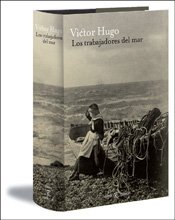

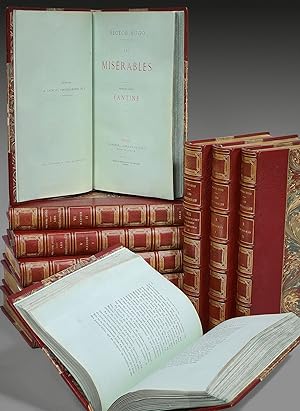


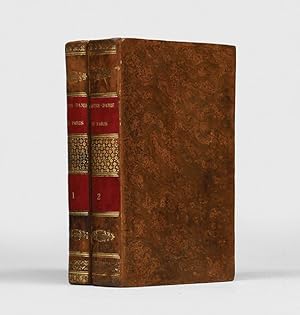
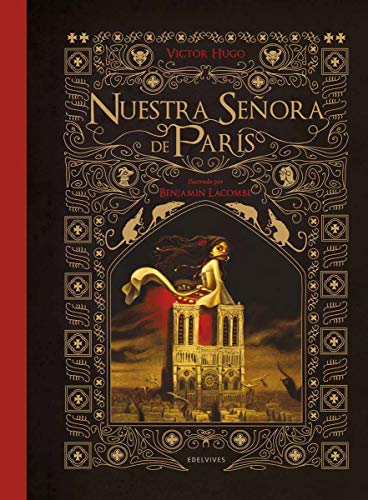
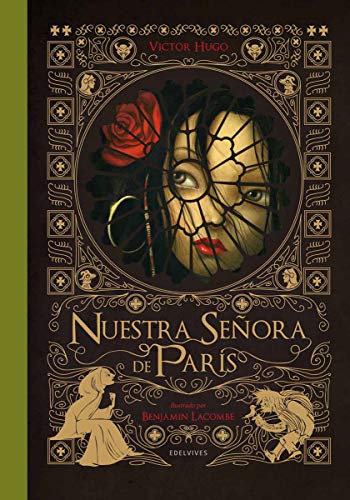
![Seller image for Notre-Dame de Paris [The Hunchback of Notre Dame] for sale by Burnside Rare Books, ABAA](https://pictures.abebooks.com/inventory/md/md31810926405.jpg)
